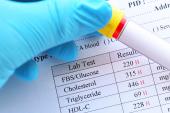Most Kids With FH Diagnosed by Cascade Screening, Albeit Late and Ineffectively
Researchers urge the development of a global screening strategy that will identify the more than 6 million children with FH.

MILAN, Italy—Children with familial hypercholesterolemia (FH) are frequently diagnosed late, mostly through cascade screening, and have considerably elevated LDL-cholesterol levels compared with children without the genetic disorder, an analysis shows.
The findings, which were presented this week at the European Atherosclerosis Society (EAS) Congress 2022, underscore the importance of an effective screening strategy adaptable internationally, particularly since some countries do not have access to advanced genetic testing, say researchers.
“One child is born with FH every minute,” said Kanika Dharmayat, MPH (Imperial College London, England), during a late-breaking clinical trials session. “If we want to screen in childhood, where we use either LDL-cholesterol [concentrations] or genetic testing, we can correctly identify the 6.4 million children that have FH right now so that we can help them and prevent any manifestation of [atherosclerotic cardiovascular disease].”
FH is an autosomal dominant disease caused by mutations in genes encoding the LDL receptor (LDLR), apolipoprotein B (APOB), or proprotein convertase subtilisin/kexin type 9 (PCSK9). The global prevalence of FH is approximately one in 300 people of all ages, meaning there are roughly 25 million worldwide with the genetic disorder, including more than six million children.
“Despite it being a common condition globally, less than 10% [of cases] have been identified to date,” said Dharmayat. “Individuals with FH have elevated LDL-cholesterol levels from birth, so it becomes imperative to identify them early so we can intervene and treat early and change the prognosis of FH individuals to match that of the general population.”
The average age of FH diagnosis among adults in the EAS Familial Hypercholesterolemia Studies Collaboration (FHSC) was 44.4 years, with just 2.0% of adults enrolled in the registry diagnosed during childhood. That late diagnosis represents a missed opportunity for treatment and a greater likelihood of atherosclerotic cardiovascular disease (ASCVD)—approximately one in six adults in the FHSC were diagnosed with coronary artery disease.
Identified Through Cascade Screening
For the new study, researchers, including senior investigator Kausik Ray, MBChB, MD (Imperial College London), sought to highlight the characteristics of children/adolescents with FH in the FHSC, including the ages they were identified, how they were identified, and how they were managed.
From the overall cohort of 63,063 FH patients, 11,231 were children/adolescents with a probable or definite diagnosis. More than 92% of cases were from Europe, with just 3.8% of cases from North, Central, and South America; 1.2% of cases from Africa; 1.1% from Eastern Mediterranean countries; and 1.8% from Southeast Asia and the Western Pacific. One-third of cases diagnosed were index cases, meaning the child was the first person in the family to be identified with FH. The remaining non-index cases were diagnoses that occurred through cascade screening after a parent and/or relative had an ASCVD event.
On average, the children were 9 years old at the time of diagnosis. Physical signs of FH, such as corneal arcus or xanthomas, were extremely rare and nearly three-quarters were identified through genetic testing. Of those in the FHSC, 27% were taking lipid-lowering medication and more than half of these patients had LDL-lowering therapy initiated after age 10.
When treatment was started, there was a reduction in LDL-cholesterol levels. “However, these children are still far from reaching the EAS-recommended threshold of 130 mg/dL,” said Dharmayat.
Already by 12 months of age, children with FH have significantly increased LDL levels compared with their counterparts without FH, she added. For those with LDL levels in the fifth percentile, LDL is still considerably higher when compared with non-FH children.
Identifying children or adolescents with FH can pose challenges. Genetic testing is the gold standard, but it isn’t available everywhere. Also, some of the criteria used to diagnose FH, such as the Dutch Lipid Clinic Network (DCLN) and MEDPED criteria, have not been adapted for children or adolescents, although the Simon Broome criteria have been modified. Children’s lipid concentrations vary by age and gender, which could lead to misdiagnosis, Dharmayat said.
The researchers point out that cascade screening is not an effective method to capture children and/or adolescents with FH, and they suggest implementing systematic screening for elevated LDL-cholesterol levels at birth or even during vaccination in the child’s first year of life in regions where genetic testing isn’t available. “If we measure LDL cholesterol in childhood, then we could have a pretty good understanding of those affected with FH, as the LDL-cholesterol levels are so far away from the non-FH children,” said Dharmayat.
Michael O’Riordan is the Managing Editor for TCTMD. He completed his undergraduate degrees at Queen’s University in Kingston, ON, and…
Read Full BioSources
Dharmayat KI, Vallejo-Vaz AJ, Stevens CA, et al. Global perspective of pediatric familial hypercholesterolemia: analysis from the EAS FHSC registry on over 11,200 children and adolescents with heterozygous familial hypercholesterolemia from 44 countries. Presented at: EAS Congress. May 23, 2022. Milan, Italy.
Disclosures
- Dharmayat reports receiving research funding from Pfizer, Amgen, Merck Sharp & Dohme, Sanofi-Aventis, Daiichi Sankyo, and Regeneron; and receiving consulting fees and/or serving on advisory boards for Bayer and Regeneron.





Comments